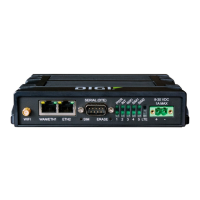Virtual PrivateNetworks(VPN) IPsec
IX20 User Guide
488
19. Click to expand Local endpoint.
a. For Type, select either:
n
Default route: Usesthe same network interface as the default route.
n
Interface: Select the Interface to beused asthe local endpoint.
b. Click to expand ID.
i. Select the IDtype:
n
Auto: The IDwill be automatically determined from the value of the tunnels
endpoints.
n
Raw: Enter an ID and have it passed unmodified to the underlying IPsec stack.
For Raw ID value, typethe IDthat will be passed.
n
Any: Any IDwill be accepted.
n
IPv4: The IDwill be interpreted as an IPaddressand sent as an ID_IPV4_ADDR
IKEidentity.
For IPv4 ID value, type an IPv4 formatted ID. Thiscan be a fully-qualified
domain name or an IPv4 address.
n
IPv6: The IDwill be interpreted as an IPaddressand sent as an ID_IPV6_ADDR
IKEidentity.
For IPv6 ID value, type an IPv6 formatted ID. Thiscan be a fully-qualified
domain name or an IPv6 address.
n
RFC822/Email: TheIDwill be interpreted as an RFC822 (email address).
For RFC822 ID value, type the ID in internet email addressformat.
n
FQDN: The IDwill be interpreted as FQDN(Fully Qualified Domain Name) and
sent as an ID_FQDN IKEidentity.
For FQDN ID value, type the ID as an FQDN.
n
KeyID: The IDwill be interpreted as a Key IDand sent as an ID_KEY_IDIKE
identity.
For KEYID ID value, type the key ID.
n
MAC address: The device's primary MAC addresswill be used as the IDand
sent as a ID_KEY_IDIKE identity.
n
Serial number: The device's serial number will be used as the IDand sent as a
ID_KEY_IDIKE identity.
20. Click to expand Remote endpoint.
a. For IP version, select either IPv4 or IPv6.
b. For Hostname list selection, select one of the following:
n
Round robin: Attempts to connect to hostnamessequentially based on the list
order.
n
Random: Randomly selects an IPsec peer to connect to from the hostname list.
n
Priority ordered: Selects the first hostname in the list that is resolvable.
c. Click to expand Hostname.

